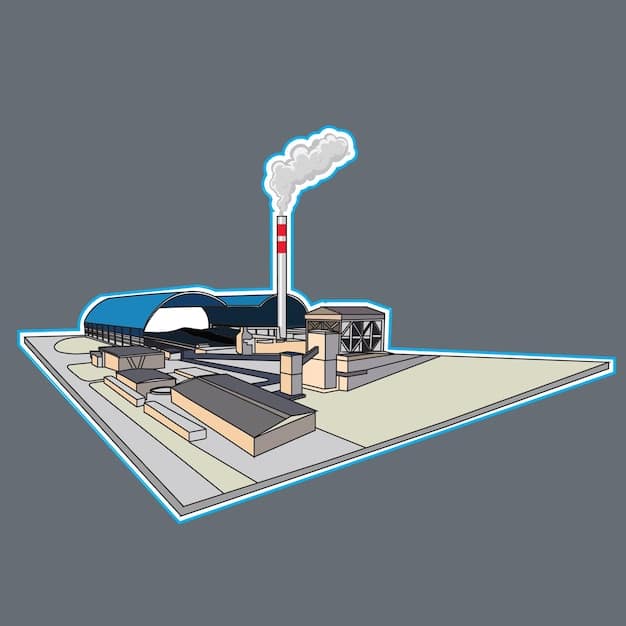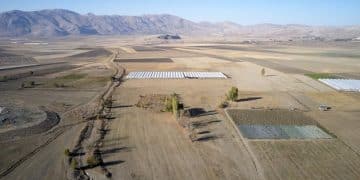Emerging Clean Energy Technologies in the US: A Promising Future

The most promising emerging technologies in the US clean energy sector include advanced battery storage, next-generation solar, carbon capture and storage (CCS), green hydrogen production, and smart grids, all poised to significantly reduce carbon emissions and enhance energy efficiency.
The US clean energy sector is experiencing a technological revolution, driven by the urgent need to reduce carbon emissions and transition to a sustainable energy future. What Are the Most Promising Emerging Technologies in the US Clean Energy Sector and Their Potential Impact? This article explores the cutting-edge innovations that are reshaping the energy landscape, offering cleaner, more efficient, and sustainable solutions for the nation.
The Rise of Advanced Battery Storage
Advanced battery storage is crucial for integrating renewable energy sources into the grid, addressing intermittency issues, and enhancing grid stability. These technologies are essential for ensuring a reliable and consistent clean energy supply.
Battery storage allows for the storage of excess energy generated during periods of high production, such as sunny or windy days, and releases it when demand is high or renewable energy production is low. This helps to smooth out the variability of renewable energy sources and ensure a consistent power supply.
Key Advancements in Battery Technology
Several advancements in battery technology are making energy storage more efficient and cost-effective.
- Lithium-ion Batteries: The workhorse of the battery storage industry, lithium-ion batteries have seen significant improvements in energy density, lifespan, and safety.
- Solid-State Batteries: Offering higher energy density and improved safety compared to lithium-ion batteries, solid-state batteries are a promising technology for the future.
- Flow Batteries: These batteries store energy in liquid electrolytes, allowing for independent scaling of energy and power, making them suitable for grid-scale storage.
Advanced battery storage is not just about improving existing technologies; it’s also about developing new materials and designs that can overcome current limitations. This includes exploring alternative battery chemistries and innovative manufacturing techniques.

The deployment of advanced battery storage systems is accelerating across the US, driven by government policies, declining costs, and increasing demand for clean energy. These systems are playing a vital role in modernizing the grid and enabling a higher penetration of renewable energy sources.
Next-Generation Solar Technologies
Next-generation solar technologies are poised to revolutionize the solar energy sector, offering higher efficiencies, lower costs, and greater versatility. These advancements are crucial for expanding the adoption of solar energy and making it a more competitive source of electricity.
Traditional silicon-based solar panels have dominated the market for years, but next-generation technologies are now emerging that promise to overcome some of the limitations of silicon-based panels, such as their relatively low efficiency and high manufacturing costs.
Promising Solar Innovations
Several innovative solar technologies are showing great promise for the future.
- Perovskite Solar Cells: Perovskite solar cells offer the potential for high efficiencies at lower costs compared to silicon-based panels.
- Bifacial Solar Panels: These panels can generate electricity from both sides, increasing energy production by up to 30% compared to traditional panels.
- Floating Solar Farms: These solar farms are deployed on bodies of water, such as lakes and reservoirs, reducing land use and potentially improving panel performance due to the cooling effect of the water.
Next-generation solar technologies are not just about improving the efficiency of solar panels; they are also about developing new applications for solar energy, such as integrating solar cells into building materials and creating flexible solar panels that can be used in a variety of settings.
The development and deployment of next-generation solar technologies are essential for achieving the goals of a clean energy future. These technologies have the potential to significantly reduce the cost of solar energy and make it accessible to a wider range of consumers and industries.
Carbon Capture and Storage (CCS) Advancements
Carbon Capture and Storage (CCS) technologies are crucial for mitigating carbon emissions from industrial facilities and power plants. CCS involves capturing carbon dioxide (CO2) emissions at their source, transporting them to a storage site, and injecting them deep underground, where they are permanently stored.
CCS technologies are seen as an essential tool for reducing carbon emissions from sectors that are difficult to decarbonize, such as cement production, steel manufacturing, and natural gas power plants. By capturing and storing CO2 emissions, CCS can help to prevent them from entering the atmosphere and contributing to climate change.
Key CCS Technologies
Several CCS technologies are being developed and deployed around the world.
- Post-Combustion Capture: This involves capturing CO2 from the flue gas of power plants and industrial facilities after combustion.
- Pre-Combustion Capture: This involves converting fuel into a mixture of hydrogen and CO2 before combustion, allowing for easier capture of CO2.
- Direct Air Capture (DAC): This involves capturing CO2 directly from the atmosphere, which can be deployed anywhere and does not require a specific emission source.
CCS technologies are not without their challenges. They require significant investments in infrastructure, including pipelines and storage sites, and there are concerns about the long-term safety and effectiveness of CO2 storage. However, ongoing research and development efforts are focused on addressing these challenges and improving the viability of CCS as a climate mitigation strategy.

The deployment of CCS technologies is accelerating in the US, driven by government incentives, industry commitments, and increasing awareness of the need to reduce carbon emissions. CCS is playing a vital role in helping the nation achieve its climate goals.
The Promise of Green Hydrogen Production
Green hydrogen production is emerging as a promising technology for decarbonizing various sectors, including transportation, industry, and power generation. Green hydrogen is produced through electrolysis, using renewable energy sources to split water into hydrogen and oxygen.
Unlike traditional hydrogen production methods, which rely on fossil fuels and generate significant carbon emissions, green hydrogen production offers a clean and sustainable alternative. By using renewable energy to power the electrolysis process, green hydrogen can be produced with virtually no carbon emissions.
Methods for Green Hydrogen Production
Various methods are used to produce green hydrogen.
- Electrolysis: This involves using electricity to split water into hydrogen and oxygen.
- Renewable Energy Sources: The electricity used for electrolysis is sourced from renewable sources such as solar, wind, and hydro power.
- Hydrogen Fuel Cells: The green hydrogen can then be used in fuel cells to generate electricity, powering vehicles, buildings, and industrial processes.
Green hydrogen production is still in its early stages of development, but it has the potential to play a significant role in the future of energy. As costs continue to decline and technology improves, green hydrogen is expected to become a more competitive and widely adopted energy carrier.
The US government is investing heavily in green hydrogen production, with the goal of becoming a global leader in this emerging technology. These investments are helping to accelerate the development and deployment of green hydrogen production facilities across the country.
Smart Grids: Enhancing Energy Efficiency
Smart grids are transforming the way electricity is delivered and consumed, enhancing energy efficiency and enabling greater integration of renewable energy sources. Smart grids use advanced sensors, communication networks, and data analytics to monitor and manage the flow of electricity in real-time.
Traditional power grids are often inefficient and prone to outages, but smart grids offer a more resilient and reliable alternative. By providing real-time information about energy demand and supply, smart grids can help to optimize energy use, reduce waste, and improve grid stability.
Key Features of Smart Grids
Several key features define smart grids.
- Advanced Metering Infrastructure (AMI): This includes smart meters that provide real-time data on energy consumption.
- Communication Networks: These networks enable two-way communication between utilities and consumers.
- Data Analytics: This involves using data to optimize energy distribution and predict potential outages.
Smart grids are not just about improving the efficiency of the electricity grid; they are also about empowering consumers to make more informed decisions about their energy use. By providing consumers with real-time data on their energy consumption, smart grids can help them to identify opportunities to save energy and reduce their electricity bills.
The deployment of smart grids is accelerating across the US, driven by government policies, utility investments, and increasing demand for energy efficiency. Smart grids are playing a vital role in modernizing the nation’s energy infrastructure and enabling a cleaner, more sustainable energy future.
Policy and Investment Landscape in the US
Government policies and investments are playing a crucial role in driving the development and deployment of emerging clean energy technologies in the US. These policies and incentives are helping to level the playing field for clean energy technologies and accelerating the transition to a sustainable energy future.
The US government offers a range of incentives for clean energy technologies, including tax credits, grants, and loan guarantees. These incentives are designed to encourage investment in clean energy and reduce the cost of these technologies, making them more competitive with traditional fossil fuels.
Key Policies and Investments
Several key policies and investments are shaping the clean energy landscape in the US.
- Inflation Reduction Act: The act includes substantial tax credits and incentives for renewable energy, energy storage, and carbon capture technologies.
- Department of Energy (DOE) Funding: The DOE funds research and development projects aimed at advancing clean energy technologies.
- State-Level Policies: Many states have implemented their own policies to promote clean energy, such as renewable portfolio standards and energy efficiency targets.
Policy and investment support for clean energy technologies is expected to continue to grow in the coming years, driven by increasing awareness of the need to address climate change and transition to a sustainable energy future. These policies and investments are essential for driving innovation, reducing costs, and accelerating the deployment of clean energy technologies across the US.
| Key Concept | Brief Description |
|---|---|
| 🔋 Advanced Battery Storage | Enhances grid stability and renewable energy integration. |
| ☀️ Next-Gen Solar | Offers higher efficiencies and lower costs for solar energy. |
| 🏭 CCS Advancements | Captures and stores CO2 emissions from industrial sources. |
| 💧 Green Hydrogen | Produces hydrogen via electrolysis using renewable energy. |
FAQ
Advanced battery storage enhances grid stability, facilitates the integration of renewable energy, and ensures a consistent power supply. It stores excess energy and releases it when needed, smoothing out any variability in renewable energy production.
Next-generation solar technologies, like perovskite solar cells and bifacial panels, offer higher efficiencies by utilizing innovative materials and designs. These technologies also reduce manufacturing costs, making solar energy more accessible and competitive.
CCS technologies capture CO2 emissions from industrial facilities and power plants, preventing them from entering the atmosphere. The captured CO2 is then transported and stored deep underground, mitigating the impact of carbon emissions on the environment.
Green hydrogen is produced through electrolysis, using renewable energy sources to split water into hydrogen and oxygen. It offers a clean and sustainable alternative to traditional hydrogen production methods, which rely on fossil fuels and generate carbon emissions.
Smart grids use advanced sensors, communication networks, and data analytics to monitor electricity flow in real-time. This optimizes energy use, reduces waste, and improves grid stability. Real-time data empowers consumers to make informed decisions about energy consumption.
Conclusion
The US clean energy sector is rapidly evolving, with emerging technologies like advanced battery storage, next-generation solar, carbon capture, green hydrogen, and smart grids paving the way for a sustainable energy future. Supported by robust policies and strategic investments, these innovations promise to significantly reduce carbon emissions and enhance energy efficiency, positioning the US as a leader in the global clean energy transition.





